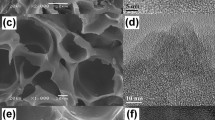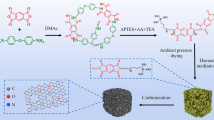Abstract
Fluorine heteroatoms were introduced to increase the limited specific capacitances of electric double-layer capacitors (EDLCs), and the effects of the fluorine atoms were analyzed. To introduce the fluorine, a CF4 plasma treatment was used that introduced the fluorine atoms quickly. Among the fluorine functional groups in the F6-ACA framework, the semi-ionic C–F bonds induced rapid charge transfer and imparted pseudocapacitance. Consequently, we achieved a specific capacitance of 325.68 F/g for the F6-CA sample at 0.5 A/g. By analyzing the contributions of the electric double-layer capacitance and the pseudocapacitance, we determined that the contribution from the pseudocapacitance was 37.57%. A remarkable specific capacitance retention rate of 95.87% was obtained over 1000 charge/discharge cycles with a high current density of 3 A/g. Additionally, the semi-ionic C–F bonds reduced the charge transfer resistance (Rct) by 36.8%. Therefore, the specific capacitance was improved by the fluorine heteroatoms, and the semi-ionic C–F bonds played a pivotal role in this improvement.




Similar content being viewed by others
Data availability
The data that support the findings of this study are available from the corresponding author upon reasonable request.
References
Huang W, Khalafallah D, Ouyang C, Zhi M, Hong Z (2023) Strategic N/P self-doped biomass-derived hierarchical porous carbon for regulating the supercapacitive performances. Renew Energy 202:1259–1272. https://doi.org/10.1016/j.renene.2022.12.032
Sun J, Zhang J, Shang M, Zhang M, Zhao X, Liu S, Liu X, Liu S, Yi X (2023) N, O co-doped carbon aerogel derived from sodium alginate/melamine composite for all-solid-state supercapacitor. Appl Surf Sci 608:155109. https://doi.org/10.1016/j.apsusc.2022.155109
Lv C, Ma X, Guo R, Li D, Hua X, Jiang T, Li H, Liu Y (2023) Polypyrrole-decorated hierarchical carbon aerogel from liquefied wood enabling high energy density and capacitance supercapacitor. Energy 270:126830. https://doi.org/10.1016/j.energy.2023.126830
Liu S, Shi D, Tu H, Yao X, Deng L, Xu D, Shao Y, Wu Y, Hao X (2021) Self-Supported Fluorine-Doped Boron Carbonitride Porous Aerogels for High-Performance Supercapacitors. Energy Technol 9:2100824. https://doi.org/10.1002/ente.202100824
Jin T, Chen J, Wang C, Qian Y, Lu L (2020) Facile synthesis of fluorine-doped graphene aerogel with rich semi-ionic C–F bonds for high-performance supercapacitor application. J Mater Sci 55:12103–12113. https://doi.org/10.1007/s10853-020-04821-1
Kim K-H, Lee JS, Ahn H-J (2021) Simultaneous effect of fluorine impregnation on highly mesoporous activated carbon used in high-performance electrical double layer capacitors. Appl Surf Sci 550:149266. https://doi.org/10.1016/j.apsusc.2021.149266
Zuliani JE, Caguiat JN, Kirk DW, Jia CQ (2015) Considerations for consistent characterization of electrochemical double-layer capacitor performance. J Power Sources 290:136–143. https://doi.org/10.1016/j.jpowsour.2015.04.019
Kwak CH, Lim C, Kim S, Lee Y-S (2022) Surface modification of carbon materials and its application as adsorbents. J Ind Eng Chem 116:21–31. https://doi.org/10.1016/j.jiec.2022.08.043
Ju P, Zhu Z, Shao X, Wang S, Zhao C, Qian X, Zhao C (2017) 3D walnut-shaped TiO2/RGO/MoO2@Mo electrode exhibiting extraordinary supercapacitor performance. J Mater Chem A 5:18777–18785. https://doi.org/10.1039/C7TA05160C
Xu S-Y, Lin L-Y, Lin H-Y (2020) Novel flexible solid-state pseudo-parallel pseudocapacitor with manganese oxide active material synthesized using electrodeposition. J Alloys Compd 843:156017. https://doi.org/10.1016/j.jallcom.2020.156017
Lei D, Li X-D, Ma M-J, Kim D-Y, Noh J-H, Kim B-S (2023) Salt-activated phenolic resin/PAN-derived core-sheath nanostructured carbon nanofiber composites for capacitive energy storage. Carbon Lett 33:699–711. https://doi.org/10.1007/s42823-022-00451-6
Zheng Y, Chen K, Jiang K, Zhang F, Zhu G, Xu H (2022) Progress of synthetic strategies and properties of heteroatoms-doped (N, P, S, O) carbon materials for supercapacitors. J Energy Storage 56:105995. https://doi.org/10.1016/j.est.2022.105995
Abbas Q, Mirzaeian M, Ogwu AA, Mazur M, Gibson D (2020) Effect of physical activation/surface functional groups on wettability and electrochemical performance of carbon/activated carbon aerogels based electrode materials for electrochemical capacitors. Int J Hydrog Energy 45:13586–13595. https://doi.org/10.1016/j.ijhydene.2018.04.099
Liu Y, Cheng X, Zhang S (2022) Hierarchically porous carbon derived from tobacco waste by one-step molten salt carbonization for supercapacitor. Carbon Lett 32:251–263. https://doi.org/10.1007/s42823-021-00271-0
Karnan M, Hari Prakash K, Badhulika S (2022) Revealing the super capacitive performance of N-doped hierarchical porous activated carbon in aqueous, ionic liquid, and redox additive electrolytes. J Energy Storage 53:105189. https://doi.org/10.1016/j.est.2022.105189
Zaman F, Ishaq MW, Munawar A, Younas U, Ali Z (2023) Aesculus indica-derived heteroatom-doped carbon as an electrode material for super-capacitor. Carbon Lett. https://doi.org/10.1007/s42823-023-00565-5
Sim Y, Surendran S, Cha H, Choi H, Je M, Yoo S, Seok CD, Jung HY, Jeon C, Kim JD, Han M-K, Choi H, Sim U, Moon J (2022) Fluorine-doped graphene oxide prepared by direct plasma treatment for supercapacitor application. Chem Eng J 428:132086. https://doi.org/10.1016/j.cej.2021.132086
Abbas Q, Mirzaeian M, Abdelkareem MA, Makky AA, Yadav A, Olabi AG (2022) Structural tuneability and electrochemical energy storage applications of resorcinol-formaldehyde-based carbon aerogels. Int J Energy Res 46:5478–5502. https://doi.org/10.1002/er.7556
Du X, Yang H-m, Zhang Y-l, Hu Q-c, Li S-b, He W-x (2021) Synthesis of size-controlled carbon microspheres from resorcinol/formaldehyde for high electrochemical performance. New Carbon Mater 36:616–624. https://doi.org/10.1016/S1872-5805(21)60033-1
Pekala R (1989) Organic aerogels from the polycondensation of resorcinol with formaldehyde. J Mater Sci 24:3221–3227. https://doi.org/10.1007/BF01139044
Kim SJ, Hwang SW, Hyun SH (2005) Preparation of carbon aerogel electrodes for supercapacitor and their electrochemical characteristics. J Mater Sci 40:725–731. https://doi.org/10.1007/s10853-005-6313-x
Fang B, Binder L (2006) A modified activated carbon aerogel for high-energy storage in electric double layer capacitors. J Power Sources 163:616–622. https://doi.org/10.1016/j.jpowsour.2006.09.014
Aghabararpour M, Motahari S, Sanaee Z, Ghahreman A (2019) Fabrication of binder-free electrode using reinforced resorcinol formaldehyde-based carbon aerogels. J Nanopart Res 21:178. https://doi.org/10.1007/s11051-019-4624-0
Mirzaeian M, Abbas Q, Gibson D, Mazur M (2019) Effect of nitrogen doping on the electrochemical performance of resorcinol-formaldehyde based carbon aerogels as electrode material for supercapacitor applications. Energy 173:809–819. https://doi.org/10.1016/j.energy.2019.02.108
Xu Y, Ren B, Wang S, Dong X, Zhang L, Liu Z (2019) Carbon aerogels with oxygen-containing surface groups for use in supercapacitors. Solid State Ion 339:115005. https://doi.org/10.1016/j.ssi.2019.115005
Wang S, Miao J, Liu M, Zhang L, Liu Z (2021) Hierarchical porous N-doped carbon xerogels for high performance CO2 capture and supercapacitor. Colloids Surf A: Physicochem Eng Asp 616:126285. https://doi.org/10.1016/j.colsurfa.2021.126285
Lu C, Huang YH, Hong JS, Wu YJ, Li J, Cheng JP (2018) The effects of melamine on the formation of carbon xerogel derived from resorcinol and formaldehyde and its performance for supercapacitor. J Colloid Interface Sci 524:209–218. https://doi.org/10.1016/j.jcis.2018.04.006
Wang K, Chen Y, Liu Y, Zhang H, Shen Y, Pu Z, Qiu H, Li Y (2022) Plasma boosted N, P, O co-doped carbon microspheres for high performance Zn ion hybrid supercapacitors. J Alloys Compd 901:163588. https://doi.org/10.1016/j.jallcom.2021.163588
Huang S, Ma D-D, Wang X, Shi Y, Xun R, Chen H, Guan H, Tong Y (2022) A space-sacrificed pyrolysis strategy for boron-doped carbon spheres with high supercapacitor performance. J Colloid Interface Sci 608:334–343. https://doi.org/10.1016/j.jcis.2021.09.179
Wang T, Zang X, Wang X, Gu X, Shao Q, Cao N (2020) Recent advances in fluorine-doped/fluorinated carbon-based materials for supercapacitors. Energy Storage Mater 30:367–384. https://doi.org/10.1016/j.ensm.2020.04.044
Ha S, Lim C, Lee Y-S (2022) Fluorination methods and the properties of fluorinated carbon materials for use as lithium primary battery cathode materials. J Ind Eng Chem 111:1–17. https://doi.org/10.1016/j.jiec.2022.03.044
Kim M-H, Yang J-H, Kang Y-M, Park S-M, Han JT, Kim K-B, Roh KC (2014) Fluorinated activated carbon with superb kinetics for the supercapacitor application in nonaqueous electrolyte. Colloids Surf A: Physicochem Eng Asp 443:535–539. https://doi.org/10.1016/j.colsurfa.2013.12.020
Zhou H, Peng Y, Wu HB, Sun F, Yu H, Liu F, Xu Q, Lu Y (2016) Fluorine-rich nanoporous carbon with enhanced surface affinity in organic electrolyte for high-performance supercapacitors. Nano Energy 21:80–89. https://doi.org/10.1016/j.nanoen.2015.12.016
An H, Li Y, Long P, Gao Y, Qin C, Cao C, Feng Y, Feng W (2016) Hydrothermal preparation of fluorinated graphene hydrogel for high-performance supercapacitors. J Power Sources 312:146–155. https://doi.org/10.1016/j.jpowsour.2016.02.057
Cao N, Wang T, Boukherroub R, Cai Y, Qin Y, Li F, Liu P, Shao Q, Liu M, Zang X (2022) Facile and secure synthesis of porous partially fluorinated graphene employing weakly coordinating anion for enhanced high-performance symmetric supercapacitor. J Mater 8:113–122. https://doi.org/10.1016/j.jmat.2021.04.012
Jung M-J, Jeong E, Kim S, Lee SI, Yoo J-S, Lee Y-S (2011) Fluorination effect of activated carbon electrodes on the electrochemical performance of electric double layer capacitors. J Fluor Chem 132:1127–1133. https://doi.org/10.1016/j.jfluchem.2011.06.046
Jung M-J, Jeong E, Lee Y-S (2015) The surface chemical properties of multi-walled carbon nanotubes modified by thermal fluorination for electric double-layer capacitor. Appl Surf Sci 347:250–257. https://doi.org/10.1016/j.apsusc.2015.04.038
Lim C, Ha S, Ha N, Jeong SG, Lee Y-S (2023) Plasma treatment of CFX: the effect of surface chemical modification coupled with surface etching. Carbon Lett. https://doi.org/10.1007/s42823-023-00597-x
Li F, Xie L, Sun G, Kong Q, Su F, Cao Y, Wei J, Ahmad A, Guo X, Chen C-M (2019) Resorcinol-formaldehyde based carbon aerogel: Preparation, structure and applications in energy storage devices. Microporous Mesoporous Mater 279:293–315. https://doi.org/10.1016/j.micromeso.2018.12.007
Ha N, Jeong SG, Lim C, Ha S, Min CG, Lee Y-S (2023) Preparation and electrochemical characteristics of waste-tire char-based CFX for lithium-ion primary batteries. Carbon Lett 33:1013–1018. https://doi.org/10.1007/s42823-023-00488-1
Kim S, Lim C, Kwak CH, Kim D, Ha S, Lee Y-S (2023) Hydrophobic melamine sponge prepared by direct fluorination for efficient separation of emulsions. J Ind Eng Chem 118:259–267. https://doi.org/10.1016/j.jiec.2022.11.011
Shen L, Li Y, Zhao W, Wang K, Ci X, Wu Y, Liu G, Liu C, Fang Z (2020) Tuning F-doped degree of rGO: Restraining corrosion-promotion activity of EP/rGO nanocomposite coating. J Mater Sci Technol 44:121–132. https://doi.org/10.1016/j.jmst.2019.09.043
Myeong S, Lim C, Kim S, Lee Y-S (2023) High-efficiency oil/water separation of hydrophobic stainless steel Mesh filter through carbon and fluorine surface treatment. Korean J Chem Eng 40:1418–1424. https://doi.org/10.1007/s11814-022-1330-x
Lim C, Kwak CH, Jeong SG, Kim D, Lee Y-S (2023) Enhanced CO2 adsorption of activated carbon with simultaneous surface etching and functionalization by nitrogen plasma treatment. Carbon Lett 33:139–145. https://doi.org/10.1007/s42823-022-00410-1
So SH, Ha S, Min CG, Lee Y-S, Park CR (2023) Effects of nitrogen plasma treatments on hydrogen storage capacity of microporous carbon at room temperature and its feasibility as a hydrogen storage material. Carbon Lett 33:1027–1034. https://doi.org/10.1007/s42823-023-00524-0
Anand S, Ahmad MW, Syed A, Bahkali AH, Verma M, Kim BH, Choudhury A (2023) Walnut shell derived N, S co-doped activated carbon for solid-state symmetry supercapacitor device. J Ind Eng Chem. https://doi.org/10.1016/j.jiec.2023.08.045
Shah A, Mao YM, Singh LR, Gogoi M, Mahato M (2022) Waste plastic-derived FWCNT-NiMgAl composite for supercapacitor application. Carbon Lett 32:1541–1557. https://doi.org/10.1007/s42823-022-00392-0
Acknowledgements
This work was supported by research fund of Chungnam National University.
Author information
Authors and Affiliations
Corresponding author
Ethics declarations
Conflict of interest
On behalf of all authors, the corresponding author states that there is no conflict of interest.
Additional information
Publisher's Note
Springer Nature remains neutral with regard to jurisdictional claims in published maps and institutional affiliations.
Rights and permissions
Springer Nature or its licensor (e.g. a society or other partner) holds exclusive rights to this article under a publishing agreement with the author(s) or other rightsholder(s); author self-archiving of the accepted manuscript version of this article is solely governed by the terms of such publishing agreement and applicable law.
About this article
Cite this article
Myeong, S., Ha, S., Lim, C. et al. Effect of fluorine functional groups introduced into activated carbon aerogel by carbon tetrafluoride plasmas in supercapacitors. Carbon Lett. 34, 65–74 (2024). https://doi.org/10.1007/s42823-023-00668-z
Received:
Revised:
Accepted:
Published:
Issue Date:
DOI: https://doi.org/10.1007/s42823-023-00668-z




